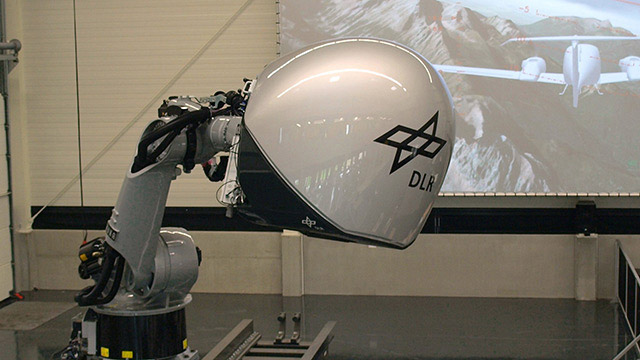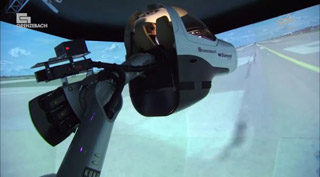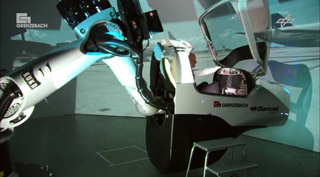 The robotic simulator models a Diamond DA42. Photo courtesy DLR.
The robotic simulator models a Diamond DA42. Photo courtesy DLR.
A new invention from Europe promises to slash the cost of advanced flight training: The German Aerospace Center (Deutsches Zentrum für Luft- und Raumfahrt, or DLR, analogous to NASA) teamed with engineers from private industry to create a first-of-its-kind take on full-motion flight simulation, one that can be made for a fraction of the cost, without sacrificing realism.
 DLR, the German Aerospace Center, teamed with industry partners Grenzebach Maschinenbau and KUKA to develop this six-axis robotic flight simulator. Photo courtesy DLR.
DLR, the German Aerospace Center, teamed with industry partners Grenzebach Maschinenbau and KUKA to develop this six-axis robotic flight simulator. Photo courtesy DLR.
Mounted on a robotic arm adapted from industry, the simulator delivers six-axis motion and a high-resolution projection display. It is capable of simulating highly unusual attitudes, including inverted flight, and is expected to be certified at Level D, the highest level of full flight simulators. Current simulators certified at this level typically use an array of six hydraulic pistons (a hexapod configuration) to move the cockpit and deliver realistic six-axis motion. Such systems must also deliver the highest possible level of visual and aural realism.
The simulator developed by DLR and industry partners is expected to cost about $1.2 million (1 million euros), while traditional Level D simulators cost seven times as much, or more. The research team hopes the new system’s lower cost will make the highly realistic simulators accessible to more pilots.
 Photo courtesy DLR.
Photo courtesy DLR.
“Our simulator enables extreme rolling and pitching movements, because there is plenty of room for the movements of the robotic arm," said DLR researcher Tobias Bellmann, a member of the public-private partnership that received the euRobotics Technology Transfer Award.
Development has been under way since 2004, when the team began to adapt robotic arms used in industry for motion simulation. Swappable cockpits allow the same basic machine to simulate a car, helicopter, or fixed-wing aircraft. The Diamond DA42 is the first training aircraft modeled by the team, and the system garnered enthusiastic reviews from test pilots drawn from the ranks of experienced airline captains and aircraft company pilots, according to a DLR news release.



